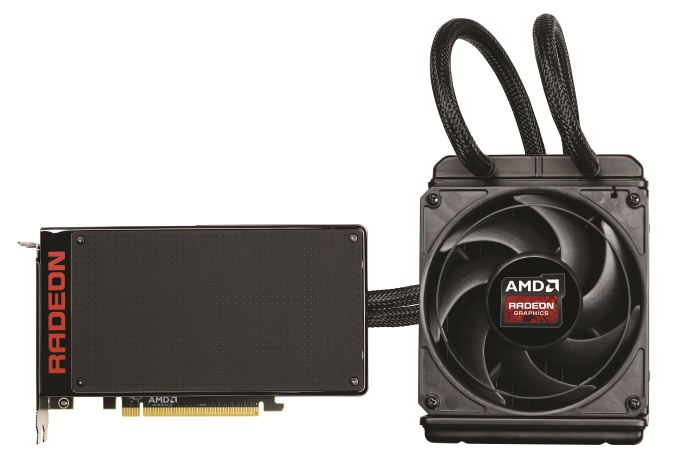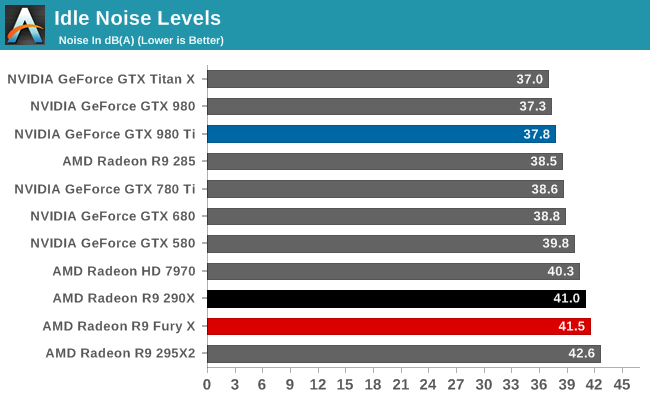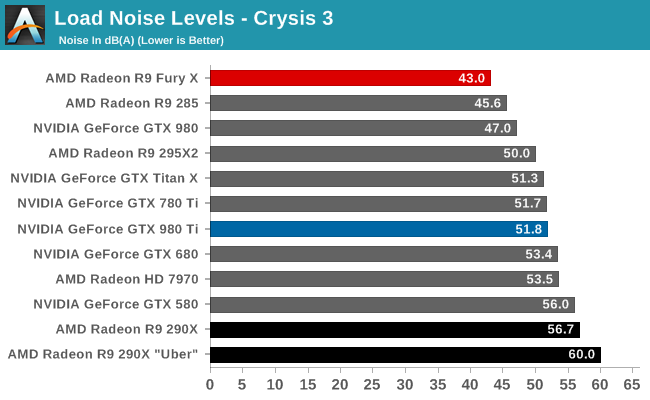On Radeon R9 Fury X Pump Noise & Replacements
by Ryan Smith on July 9, 2015 9:20 PM EST
On a meta note this evening, over the last week I have received a number of questions about last week’s Radeon R9 Fury X review. Several of these questions were regarding the matter of pump noise, a matter which has been called into question for the original run of R9 Fury X cards.
As a quick reminder, here’s what the noise situation looks like on the R9 Fury X.


In short, the R9 Fury X has great overall noise performance under load. However the pump doesn’t idle all that well, and as a result its idle noise performance is second only to the R9 295X2, a card with two pumps. Compared to contemporary competitors like the GTX 980 Ti, the R9 295X2 ends up being just under 4dB(A) louder than the competition, a not insignificant amount when we’re talking about idle noise levels, and is why we don’t believe the R9 Fury X to be a good fit for HTPCs or other environments where idle noise is of great concern.
Meanwhile there is a secondary matter, which is the tone of that noise. Several of our colleagues, including Tom’s Hardware, PC Perspective, and The Tech Report, have reported that their samples are producing a whining noise. This was not an issue with our sample, and is the crux of the questions I have received on the matter.
So to get right to the point and to answer those questions sent my way, does the R9 Fury X whine? The fact that as many other empirical-minded sites are reporting issues and that AMD has issued a statement on the matter (more on this later) certainly points to a whining issue that needed to be addressed.
At the same time I’ve also had several people ask if our card is somehow different – why we aren’t experiencing whining – and the best answer there is due to variation in the production process leading to different amounts of noise from each card. Just like chip quality there will be minute variations in each card produced, and in this case our card would appear to have varied in such a way as to not suffer from vibrational issues to the same extent as some other cards, dampening enough to eliminate the whining (or at least make it unnoticeable). Which again, just like chip quality variations, doesn't mean our card is identical to all other cards, only that in our specific case we aren't experiencing whining, and is why we haven't had any whining to report on so far. Meanwhile I would also note that our testing is with a closed case, however the case is open for noise testing to more directly measure the video card.
In any case, for current Fury X owners and any prospective buyers, AMD has issued a statement earlier in the week, essentially addressing the issue and discussing how it is being resolved in latter batches.
We have received feedback that during open bench testing a small number of Fury X cards emit a sound from the high speed liquid cooling pump that, while not loud, is bothersome to some users. While the vast majority of initial Fury X owners report remarkably quiet operation, we take this feedback seriously, as AMD’s mission is to always deliver the best possible experience to our Radeon customers.
AMD Radeon R9 Fury X customers demand and deserve the best, so adjustments in the sound baffling adhesive compound were applied in the assembly of the high speed cooling pump to address the specific sound a few end users experienced as problematic. This improved the acoustic profile of the pump, and repeat testing shows the specific pitch/sound in question was largely reduced through adjustments to the sound-baffling adhesive compound in the pump.
AMD will work with its graphic card partners to ensure the satisfaction of the small number of initial customers who observed this specific sound and experienced it as bothersome. AMD is confident that on-going production of Radeon R9 Fury X product reduces the specific sound in question, but this is also a highly subjective matter with wide differences in PC case builds and room acoustics.
The AMD Radeon™ R9 Fury X radiator fan is near silent, and this makes any sound from the high-speed pump more noticeable to some end users, especially during open bench testing. Thus although the overall sound levels are remarkably low for an enthusiast product, AMD has worked to reduce the specific sound that some customers report as bothersome.
AMD for their part believes that the issue has been resolved going forward, and that is something that will need to be tested as the newer batches become available.
Finally, in the meantime there is the matter of the existing cards. AMD’s statement unfortunately doesn’t address the matter, though this is not unexpected since they aren’t directly selling the card to consumers. From what we’re hearing, the board partners are addressing this matter themselves, so any current Fury X owners experiencing pump whining would need to go to their board partner that sold their card for support.
The catch at the moment is that after the initial launch, new R9 Fury X cards remain sparse. A quick check on stock history for the card shows that while new shipments come in almost daily, they also sell out in under an hour, which indicates that cards are hard to come by. So depending on how many support requests are filed and how board partners address the issue, it may not be possible to replace every problematic card at once. Though to be clear, this is speculation on our part.











47 Comments
View All Comments
Stuka87 - Friday, July 10, 2015 - link
It was through NewEgg as I stated, not the manufacturer.bill.rookard - Friday, July 10, 2015 - link
I'm sure NewEgg has quite a bit of leverage with most of the actual manufacturers (Sapphire, Zotac etc) and if they push for their customers, I'm sure the units could be returned, 'adhesively retuned' and eventually resold at a discounted price as 'factory refurb'.toyotabedzrock - Friday, July 10, 2015 - link
If it is just the pump they don't need new cards, just a reassembly of the pump or at worst a new one which I'm sure they have plenty of.Samus - Friday, July 10, 2015 - link
OEM's and partners don't want end-users to replace the pumps, since it is integrated with the water block.Unfortunately AMD made the mistake of using cooler master for their cooling solution partner. This isn't surprising since Cooler Master is the largest OEM cooling solution provider in the world. HP/Compaq used them exclusively for years.
However, I think the entire community would agree with me that Asetek, hands-down, has the best off-the-shelf closed loop solutions. Antec and Corsair used Asetek almost exclusively for years until finally coming up with their own (mostly inferior) solutions.
Asetek pumps are VERY quiet and offer variable speed unlike many cooler master pumps that just cut out below 9 volts.
ES_Revenge - Sunday, July 12, 2015 - link
Agreed. Pretty much just posted the same thing, before I read your post!Achaios - Friday, July 10, 2015 - link
AMD seems to be plagued by people who are either bad professionals or by people who work such long hours (16 hours+ per day) that they make mistakes. It seems that in almost every product launch we have to read about the inevitable AMD screwup.Then we have got the R9 Fury X, a GPU which no matter how one looks at it, doesn't make sense. In addition to AMD fitting the card with a cooler with an inherent vice, the GPU performs worse than the 980 Ti and retails at the same price.
I really can't see why I should buy the R9 Fury X, driver issues notwithstanding. (In order to be nice to AMD folks, I didn't even mention the driver problems AMD cards suffer from).
jabber - Friday, July 10, 2015 - link
I think it's called 'trying something new'. Sometimes it takes a little while to gain traction but it has to be done occasionally.Jigar2speed - Friday, July 10, 2015 - link
Come on man, this driver story is so old i am not even sure when i last had issues with AMD drivers, plus unlike Nvidia, AMD drivers performance increase is liner...Creig - Friday, July 10, 2015 - link
And then there's the Nvidia screw-ups. Let's see, the GTX 970 was advertised for four months as having 64 ROPs and 2MB of cache (it doesn't), it effectively has 3.5 GB of usable memory while the last 0.5 MB has been speed crippled.And yes, it's a good thing you didn't mention driver issues or we'd also have to bring up all the instability issues Nvidia has been having with their drivers, the lack of optimization for Kepler card owners, the Nvidia drivers that cooked their own cards by turning off the cooling fan, etc.
Really, AMD is no worse than Nvidia when it comes to making cards/drivers.
Really, the "AMD has driver issues" is no worse than "Nvidia has driver issues" these days.
Oxford Guy - Monday, July 13, 2015 - link
Good post, although Nvidia's refusal to correct the specs for the 970 or take any other action beyond admitting to their fraud to this site suggests screw-up, in terms of an accidental one, is not the correct term.Then, there is common sense — which makes it very hard to believe that their executives and no idea what the engineering team was creating/created. It's one whopper to claim marketing didn't know, but the suits as well? Only suits would think selling an enthusiast-price card, often in SLI pairs no less, would warrant a purposefully hobbled design (half the VRAM speed of a 2007 midrange card plus XOR contention).